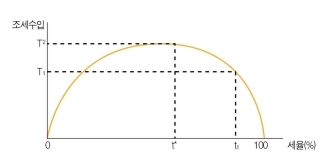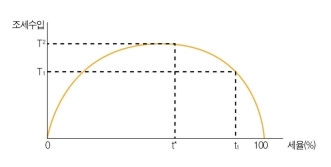
래퍼곡선
미국의 경제학자 래퍼(A. Laffer)가 제시한 조세수입과 세율 간의 관계를 나타낸 곡선 을 말한다. 래퍼는 세율이 0%에서 100%로 증가할 때 조세수입은 상승하다가 정점에 이른 후 다시 하강한다면서, 세율(t)을 수평축에 조세수입(T)을 수직축에 놓고 이들의 관계를 그려보면 아래 그림과 같이 “역 U자 모양의 곡선”이 된다고 주장하였다. 래퍼곡선 (Laffer curve)에 따르면 세율이 높아지면 초기에는 세수가 늘어나나 일정 수준(t*)이 넘으면 오히려 감소하므로 현재의 세율이 세수가 가장 많은 수준(t*)을 넘지 않았다면 세수증대를 위해서는 세율을 올려야 하며 반대로 현재의 세율이 세수가 가장 많은 수준을 넘었다면 감세가 세수증대에 도움이 된다. 래퍼곡선은 미국 레이건 정권의 감세 정책을 뒷받침한 이론적 근거로 널리 이용되었으나 조세수입을 극대화시키는 최적세율 이 어느 정도 수준인지는 정확하게 제시하지 못한다는 한계가 있다.

레그테크
레그테크(RT; RegTech, Regulatory Technology)는 금융업 등 산업 전반에 걸쳐 혁신 정보기술(IT)과 규제를 결합하여 규제관련 요구사항 및 절차를 향상시키는 기술 또는 회사를 뜻한다. 이는 금융서비스 산업의 새 영역이자 일종의 핀테크(FinTech)이다. 레그테크회사들은 수작업의 자동화, 분석 보고절차의 연결, 데이터 품질 개선, 데이터에 대한 전체적인 시각의 창출, 절차관련 앱(application)에 의한 데이터 자동 분석, 핵심 사업에 대한 의사결정 및 규제당국 앞 송부용 보고서 생산에 초점을 맞춘다. 레그테크의 핵심 특징은 ① 민첩성(잡다하게 얽힌 데이터 세트의 분리 및 조직화) ② 속도(speed, 신속한 보고대상의 인식 및 산출) ③ 통합(단기간에 해결책 확보 및 운영) ④ 분석(‘빅데이 터’의 채굴 및 그 진정한 잠재력 파악을 위한 분석 도구의 활용) 등이다.
레버리지 효과
안정성을 추구하는 저축과 달리 투자에서는 종종 레버리지 효과(leverage effect)가 발생한다. 금융에서는 실제 가격변동률보다 몇 배 많은 투자수익률이 발생하는 현상을 지렛대에 비유하여 레버리지로 표현한다. 투자에서 가격변동률보다 몇 배 많은 투자수익 률이 발생하려면, 즉 레버리지 효과가 나타나려면, 투자액의 일부가 부채로 조달되어야 한다. 레버리지 효과는 총투자액 중에서 부채의 비중이 커지면(자기자본의 비중이 작아 지면) 증가하게 된다. 원천적으로 레버리지가 내재한 투자의 예로, 전세를 끼고 주택을 매입한 경우를 상정하자. 10억원인 아파트를 8억원의 전세를 끼고 자기자본 2억원으로 매입하였다면, 투자 레버리지(=총투자액/자기자본)는 5배(=10억원/2억원)가 된다. 이후 집값이 10% 상승하여 11억원이 되면 자기자본 2억원에 대한 투자수익률은 실제 가격변 동률(10%)의 5배인 50%가 된다. 만일 집값이 30% 하락하여 7억원이 되면 투자수익률은 실제 가격변동률(-30%)의 5배인 -150%가 되어 집값이 전세값에도 못 미치는 소위 ‘깡통 전세’로 전락하게 된다. 이와 같이 레버리지에 의해 손익이 확대되는 효과가 발생하므로 레버리지는 ‘양날의 칼’에 비유되기도 한다. 1997년말 한국에 외환위기가 닥쳤을 때 많은 사업자와 기업이 파산하게 된 원인 중 하나가 높은 부채비율로 인한 레버리지였다. 그러므로 투자를 할 때는 감내할 만한 수준 이내로 부채를 적절하게 사용하는 것이 바람직하다.
Rapper curve
It refers to a curve showing the relationship between tax revenue and tax rate proposed by American economist A. Laffer. Rapper argued that when the tax rate increases from 0% to 100%, tax revenue rises, peaks, and then falls again, and if you draw their relationship with the tax rate (t) on the horizontal axis and the vertical axis, it becomes an "inverse U-shaped curve." According to the Laffer curve, if the tax rate rises, the tax revenue increases initially, but if the current tax rate does not exceed a certain level (t*), the tax rate must be raised to increase tax revenue, and if the current tax rate exceeds the highest level (t*). The rapper curve was widely used as a theoretical basis for the Reagan administration's tax cut policy, but there is a limit that it does not accurately present the optimal tax rate for maximizing tax revenue.

Leg Tech
RegTech (RT) refers to a technology or company that improves regulatory requirements and procedures by combining innovative information technology (IT) and regulations throughout industries such as the financial industry. This is a new area of the financial service industry and a kind of FinTech. Regtech companies focus on manual automation, linking analysis reporting procedures, improving data quality, creating a holistic view of data, automatic analysis of data by procedural applications, decision-making on core businesses and report production to regulators. Key features of LegTech include 1. Agility (separation and organization of complex datasets) 2. Speed (recognition and production of fast reporting targets) 3. Integration (getting and operating solutions in a short time) 4. Analysis (mining 'big data' and using analysis tools to identify its true potential).
Leverage effect
Unlike savings that seek stability, leverage effects often occur in investments. In finance, the phenomenon in which the return on investment occurs several times more than the actual price change rate is expressed as leverage by comparing it to leverage. In order for an investment to generate a return on investment that is several times greater than the rate of change in price, that is, for the leverage effect to appear, a part of the investment must be financed by debt. The leverage effect increases as the proportion of debt among total investments increases (as the proportion of equity capital decreases). As an example of an investment with inherent leverage, let's assume a case of purchasing a house with a lease. If an apartment worth 1 billion won is purchased with equity capital of 200 million won with a lease of 800 million won, the investment leverage (=total investment/equity capital) is five times (=1 billion won/200 million won). Since then, when housing prices have risen by 10% to 1.1 billion won, the return on investment in 200 million won in equity capital will be 50% which is five times the actual price change rate (10%). If housing prices fall 30% to 700 million won, the return on investment will be -150%, five times the actual price change rate (-30%), which will degenerate into a so-called "can lease" where housing prices are less than the lease price. In this way, leverage has the effect of expanding profits and losses, so leverage is sometimes compared to a "double-edged sword." One of the reasons that caused many businesses and companies to go bankrupt when the financial crisis hit Korea in late 1997 was leverage due to the high debt ratio. Therefore, it is desirable to appropriately use debt within tolerable levels when investing.
"이 포스팅은 쿠팡 파트너스 활동의 일환으로, 이에 따른 일정액의 수수료를 제공받습니다."
'경제금융용어' 카테고리의 다른 글
| 리디노미네이션,마샬의 k,마스트리히트조약 (0) | 2023.09.13 |
|---|---|
| 레버리지비율,로렌츠곡선,로보어드바이저 (0) | 2023.09.13 |
| 디스인플레이션,디커플링/커플링,디플레이션 (2) | 2023.09.12 |
| 듀레이션,등록발행,디레버리징 (0) | 2023.09.12 |
| 동일인/특수관계인,동태적 대손충당금 제도,동행종합지수 (0) | 2023.09.12 |




